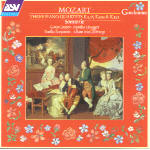The HIP-ster (historically informed practice) qualifications of these players are legion and well-documented–you’ll find the names of violinist/Sonnerie director Monica Huggett and her colleagues on dozens of very fine recordings. Mozart falls later chronologically than the early and baroque base of these musicians’ more regular operations (the ensemble’s size and membership changes with the requirements of the repertoire), but these performances are an excellent reminder of some of HIP’s benefits–in this case, laser-like focus and brightly tinted colors. Sonnerie plays a muscular, angular Mozart that throws the composer’s ideas into sharp relief; and although this approach usually is quite successful, its interpretive tread is sometimes just too heavy for Mozart’s lighter moods and textures. The G minor’s Allegro isn’t just stern, it’s out-and-out churlish, harrumphing through the first theme and never letting up.
But there is much joy here, too, especially when fortepianist Gary Cooper is in the limelight. In the two E-flat quartets (K. 493 and K. 452, the latter an arrangement of an earlier wind quintet), the piano is the unquestionable star, and Cooper’s elegant, lithe playing is a real pleasure. This is particularly true in K. 493’s Larghetto, which functions almost as a piano concerto’s slow movement, with a tiny ensemble accompanying the soloist. The sound is quite good, if a bit too narrowly confining.
































